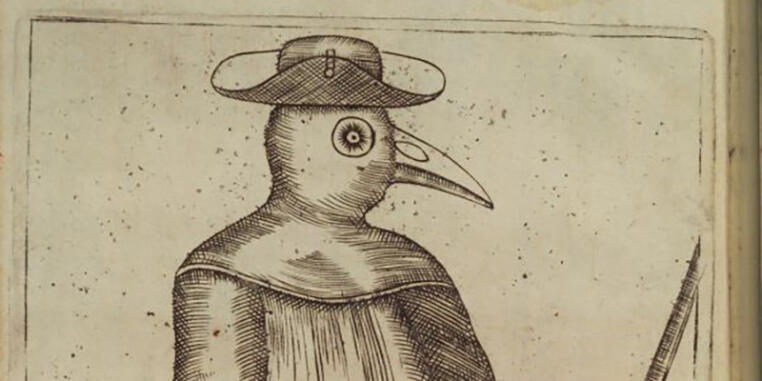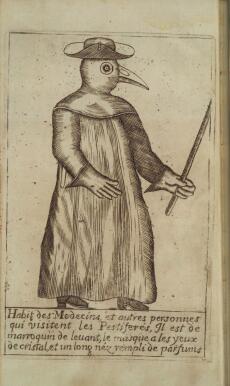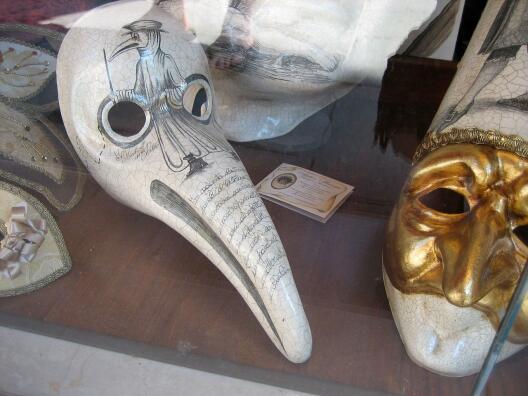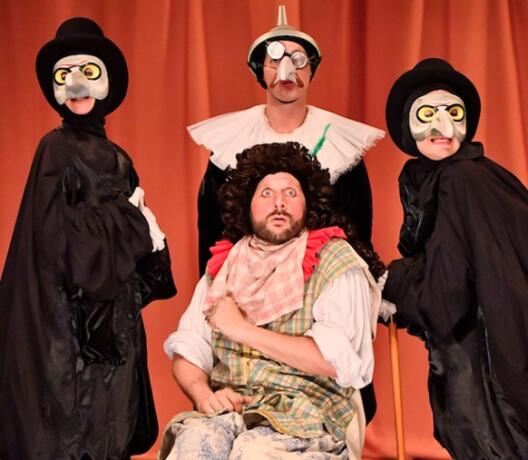The extraordinary career of the Plague Doctor
By literary scholar Pia Claudia Doering (Romance studies)

The beak mask worn by the Plague Doctor is of secondary importance in medical history. This is clearly demonstrated by the work of the medical historian and director of the German Museum of Medical History, Marion Maria Ruisinger. From the perspective of cultural history, however, the plague mask has become very well-known and is firmly anchored in collective memory as a symbol of the danger of infection emanating from epidemics, but also of illness and death.

In the Middle Ages, at the time of the Great Plague (1347-1351), doctors did not yet wear masks against the plague. To reduce the risk of infection via the air that they breathed (see the article Miasmas, particles, tinder, plague worms, and “levende diertjens”. On how microbes have been made visible for humans by Katharina Wolff in the dossier ), they held bags of aromatic herbs soaked in vinegar in front of their noses when visiting the sick. It was not until the 17th century, possibly based on an idea by Charles Delorme, Louis XIII’s personal physician, that a holder for the fragrances was developed. Placed directly under the nose, this allowed the air to be purified continuously, while enabling the doctor to move his hands freely. This device gave rise to the beak that is so well-known today, this beak being part either of a mask (Fig. 1) or of a hood (Fig. 2).

The fact that doctors wore such a beak-like and fragrance-filled nasal sheath is documented geographically only for France and Italy, and historically only for plague outbreaks since the 17th century. There is no evidence, for example, that plague masks were used either in the time beforehand or in the German-speaking countries. Thus, although the beak mask is only a marginal phenomenon from the viewpoint of medical history, it is still present today in the form of carnival and theatre masks, in pictures and texts, and beyond the borders of Italy and France. The great symbolic significance of the mask is particularly evident in the fact that it is now worn in a range of different contexts. For example, the medico della peste is one of the most well-known figures in the Venetian carnival (Fig. 3).

In addition, the mask also appears in contexts where it does not really fit according to the criterion of historical correctness – for example, at medieval markets and in productions of the medieval plague. And the mask of the Plague Doctor can now be found even in the theatre, which has its own tradition of masks, although it did not originally belong to the collection of masks of the Commedia dell’arte, for example. In many current productions of Molière’s medical satires, such as Monsieur de Pourceaugnac (1669) and Le malade imaginaire (1673), the doctors wear frightening or comical beak masks (Fig. 4). This is despite the fact that the plays are not about the plague, and the original costumes of the 17th century did not feature masks, but instead scholarly clothing with elaborate hats and wigs as the costume of the doctor.

The fact that Molière’s physicians can be seen on stage today wearing a beak mask is due to the visual effect of the Plague Doctor: the mask points in a narrower sense to the scepticism of laypeople towards medical experts, whom patients are forced to confide in, although they understand the specialist jargon just as little as they can recognize the faces behind the mask. Beyond its specific meaning in the medical satire, however, the plague mask always reminds us in a broader sense of our mortality and of our fear of death.

